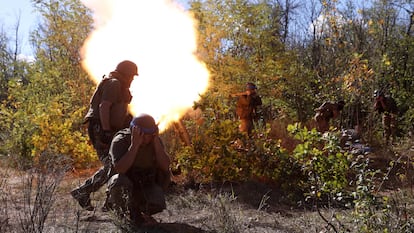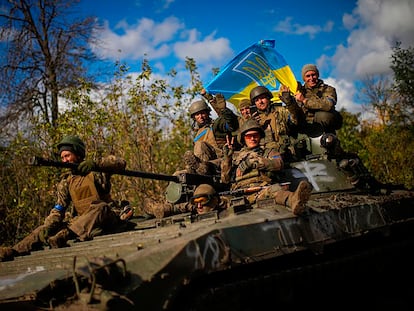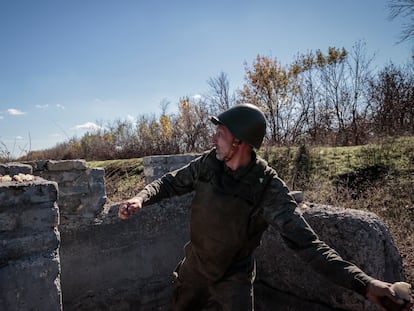Ukraine pushes Russian troops back in Luhansk as Putin signs annexation decree
Three civilians were killed and a dozen wounded in a missile attack against residential buildings in Zaporizhzhia, local authorities said. Moscow is claiming control of the city’s nuclear plant


Several explosions rocked the southern Ukrainian city of Zaporizhzhia on Thursday, hours after Russian troops launched an attack on residential buildings. At least three people were killed in early morning shelling and 12 more were wounded, regional governor Oleksandr Starukh said on his Telegram account.
“At least five people are under the rubble of the building,” wrote the governor, adding that many people have been saved, including a three-year-old girl who was being treated by specialists. Starukh has asked residents to take shelter again as there is a “high probability” of further strikes. The attack came days after at least 30 people were killed and 88 others wounded when Russian missiles struck a civilian convoy in the same area.
Zaporizhzhia is one of the four Ukrainian territories that Russia illegally annexed last week along with Donetsk, Luhansk (both in the northeast) and Kherson (in the south) following referendums considered illegal by the international community. On Thursday, Putin signed a decree of entry into the Russian Federation for the four annexed territories.
Ukrainian President Volodymir Zelenskiy on Thursday accused Russia of “nuclear blackmail” because of its takeover of the Zaporizhzhia nuclear power plant, Europe’s largest, which Russian forces seized in March, although Ukrainian staff have continued to operate it. The head of the International Atomic Energy Agency (IAEA), Rafael Mariano Grossi, was due in Kyiv on Thursday as part of an ongoing effort to establish a safety zone around the disputed facility, which Moscow now considers to be on Russian territory following the illegal annexation.
Recaptured territory

The Ukrainian military’s counteroffensive against Russian positions in the east has recaptured several villages in Luhansk, a region of the Donbas zone that has for months been almost entirely under the control of Russia’s occupying forces. Kyiv’s strategists have had their eye on gaining ground in the territory for some time. “Well, now it’s official: the liberation of the Luhansk region has begun,” Sergei Haidai, the Ukrainian governor of Luhansk, said on Tuesday on his Telegram account. Haidai added that six villages had been liberated but did not specify exactly where the yellow and blue flag of Ukraine had been hoisted anew. However, the official also confirmed that intense fighting is ongoing in some areas. The UK Ministry of Defense has confirmed that Ukrainian troops are advancing east of the Oskil River, in the northeast of the country, through the Kharkiv region and towards the dividing line between Russian-held territory in Luhansk and advancing Ukrainian units.
The Russian army is desperately attempting to hold on to some of its positions in the eastern zone despite a chronic lack of food and equipment, while at the same time seeking to hasten the enlistment of draftees to swell its ranks in the occupied areas, according to Haidai. Some soldiers, the Ukrainian official claimed, have even deserted back to the other side of the Russian border given the impossibility of remaining on the front lines. To fill this void, Haidai said training camps have been set up in Luhansk where prisoners are being transported in from Russian jails and hastily prepared to join the ranks of the Wagner Group, a paramilitary organization headed by Lieutenant Colonel Dimitriy Utkin, a GRU special forces officer and a personal friend of Vladimir Putin, for whom the unit serves as a de facto private army. In hospitals, Haidai said, many civilian patients are being discharged to make room for the increasing number of wounded troops requiring treatment.
Pro-Russian authorities in Luhansk have acknowledged that the situation is “alarming” in the town of Svatove due to the advance of the Ukrainian counter-offensive. An attack on the road between Svatove and the city of Kreminna would reduce the supply capacity of Kremlin troops deployed in eastern Ukraine, British intelligence said on Wednesday. However, Russian commanders consider the situation still “under control,” according to the Luhansk representative in Moscow, Rodion Miroshnik.
As was the case a month ago with the counteroffensive deployed by Kyiv in the Kharkiv region, the Kremlin has announced it has issued an order for the tactical withdrawal of its troops from the Luhansk area while acknowledging the advance of Ukrainian forces on the ground. The Russian Ministry of Defense, through the maps with which it produces daily reports on the conflict, has admitted a Russian retreat on both the eastern and southern fronts.
In the south, where the Kherson region forms the other front of the Ukrainian counteroffensive, the withdrawal of the Kremlin’s troops has been accompanied by the destruction of their own ammunition and of bridges to slow the Ukrainian advance. Roads, infrastructure and even houses have also been mined, according to the Armed Forces of Ukraine. Meanwhile, Zelenskiy has announced that Kyiv’s forces are regaining control of dozens of previously occupied enclaves. For its part, Russia has vowed to recover the liberated areas. “We are working on the assumption that the situation in the territories incorporated into Russia will stabilize,” said Kremlin spokesman Dmitry Peskov.

Russia formally signs annexation decree
The Ukrainian advance in the east came on the same day that Putin signed a decree of entry into the Russian Federation for the four annexed territories, a gesture that has not been recognized as legal or official by any country or institution worldwide. Putin also signed a document by which the Kremlin now considers the Zaporizhzhia nuclear power plant, which has been under the control of occupying forces since the early stages of the invasion, to be a Russian possession. Grossi is in Kyiv to resume discussions over the creation of a demilitarized zone around the plant, stating: “It is now more urgent than ever.” Russian Deputy Foreign Minister Sergey Vershinin said in response after Putin’s decree that any developments at the plant “should be carried out under the leadership of our departments.”
The decree signed by Putin represents the annexation of more than 15% of Ukraine’s 600,000 square kilometer (231,660 square mile) territory. As of 2014, Moscow has also illegally occupied Crimea, which raises the proportion of Ukraine that the Kremlin now considers to be Russian territory to more than 22%. “They will be Russia forever,” said Peskov, reinforcing Moscow’s position even as the European Union imposed a fresh tranche of sanctions on Russia.
Tu suscripción se está usando en otro dispositivo
¿Quieres añadir otro usuario a tu suscripción?
Si continúas leyendo en este dispositivo, no se podrá leer en el otro.
FlechaTu suscripción se está usando en otro dispositivo y solo puedes acceder a EL PAÍS desde un dispositivo a la vez.
Si quieres compartir tu cuenta, cambia tu suscripción a la modalidad Premium, así podrás añadir otro usuario. Cada uno accederá con su propia cuenta de email, lo que os permitirá personalizar vuestra experiencia en EL PAÍS.
¿Tienes una suscripción de empresa? Accede aquí para contratar más cuentas.
En el caso de no saber quién está usando tu cuenta, te recomendamos cambiar tu contraseña aquí.
Si decides continuar compartiendo tu cuenta, este mensaje se mostrará en tu dispositivo y en el de la otra persona que está usando tu cuenta de forma indefinida, afectando a tu experiencia de lectura. Puedes consultar aquí los términos y condiciones de la suscripción digital.
More information

Ukrainian army meets little resistance as it approaches city of Kherson
Últimas noticias
Most viewed
- Reinhard Genzel, Nobel laureate in physics: ‘One-minute videos will never give you the truth’
- Oona Chaplin: ‘I told James Cameron that I was living in a treehouse and starting a permaculture project with a friend’
- Pablo Escobar’s hippos: A serious environmental problem, 40 years on
- Why we lost the habit of sleeping in two segments and how that changed our sense of time
- Chevy Chase, the beloved comedian who was a monster off camera: ‘Not everyone hated him, just the people who’ve worked with him’









































